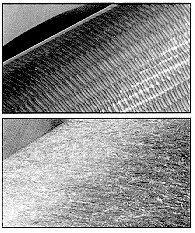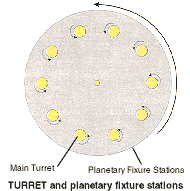Drag Finishing
Is this the mass-finishing answer you have been looking for?
When we think of deburring, radiusing or polishing (i.e., mass finishing), we tend to think of traditional tumblers or vibrators. However, if you have high-value contoured parts that cannot withstand part-on-part contact, and hand labor is too expensive or inconsistent, then drag finishing may be the answer.
In most conventional mass-finishing machines parts are placed loose in some type of grinding or finishing media. The machine uses vibratory or rotational motion to move media across the surface of the parts. Unfortunately, the parts are also moved by the same forces, creating the possibility of part-on-part contact. If the contoured parts require a nick-free, consistent finish achieved using speeds up to 40 times faster than conventional methods, then drag finishing may be for you.
The concept of drag finishing goes back centuries to when farmers first pulled plows through their fields. Although the farmers' intention was not to deburr or polish their plows, dragging the plow through the abrasive soil did just that.
The initial thesis work of drag finishing's developer focused on the need for a machine that would increase performance levels over conventional mass-finishing equipment. The "think-tank" design people knew that pressure and velocity were responsible for the work of mass finishing; therefore, drag finishing was the natural result.
As you visualize a plow cutting through a field, you can appreciate the significance of these physical elements. It is the magnitude of these two elements that provides drag finishing an advantage. Subsequent experience taught the developer that these two elements, in concert with properly prescribed media and compounds, allow drag finishing to achieve performance levels as high as 40 times faster than conventional levels.
Drag finishing uses a circular bowl containing stationary, loose finishing media and a circular rotating turret above the bowl with multiple rotating part-fixture stations. (Ten stations are average.) Fixture stations rotate about their own axes, similar to a planetary system.
Parts are attached singularly or in groups to part-fixture stations around the perimeter and under the main turret. The rotating turret is then lowered so the parts are submerged and "dragged" through the stationary loose media.
Programmed sequences such as rpm, depth and rotational direction provide mechanical repeatability that assures uniformity cycle to cycle. By combining the right media and compound with the physical action of the drag finisher, you can mechanize processes that previously only could be done manually. Refined surfaces as low as one to two Ra (Roughness average) are consistently achievable.
Drag finishers are relatively large machines, ranging from 84 to 168 inches in diameter. They can have a one-, two- or three-bowl configuration to accommodate multiple media processes. Bowl capacity is determined by the size and production requirements of the product.
Parts need to be fixtured in a drag finisher. When trials are conducted in feasibility studies, the fixtures are simple. The focus is on whether the process has merit for that particular part. Once success is achieved with the trial parts, and the media, compound and machine parameters are defined, then production fixtures can be dealt with.
Drag finishing systems feature a selection of quick-change couplings attached to the rotating fixture stations: air-actuated, mechanical, hydraulic and manual. These quick couplers allow a second set of fixtures to be loaded with parts while the machine is running. When the machine's cycle is complete, the second set of parts is exchanged for the finished parts, maximizing machine use.
Fixturing and processing in a drag finisher are not limited to rotating planetary fixture stations. Often large parts, like diecast housings, turbine blades or long forgings, can be attached in many ways.
Step-milled aluminum forgings, several feet long, are acceptable for drag finishing. The milling process leaves step marks every 10 to 20 thousandths of an inch. Blending these step marks is critical, and, if done manually, requires highly trained and expert people.
Automated sequences using a programmable controller provide consistency. Controllers can be programmed with process parameters such as rpm, depth, water flow rate, rotation direction and process time. Controllers can be set up to accept part numbers that identify a processing sequence unique to that part, again providing consistency from run to run.
Whether your finishing need is aesthetically or functionally driven, drag finishing can provide various finishes for a broad industrial market. For the aerospace, automotive, medical, recreational as well as other industries, drag finishing is capable of furnishing processes requiring functional Tp (Measurement of the amount of contact area on a part) bearing ratios of 98 to 100 pct at Ra levels down to one to two Ra, as well as aesthetically pleasing finishes.
For example, medical implants are perhaps one of the smoothest and most highly polished parts manufactured today. The principal reason for an implant's smooth surface is not aesthetics, but the need to develop extremely fine Tp bearing ratios as close to 100 pct as possible. Implants must function as close as possible to what Mother Nature intended.
At the other end of the scale, there is a need for aesthetically pleasing stainless steel components. Golf clubs, boat propellers and hardware require highly polished surfaces. Highly polished automotive aluminum wheels are another example of parts needing fine finishes for high luster or pre-plate applications.
Parts exposed to corrosive environments such as salt water need properly prepared surfaces. Drag finishing prepares surfaces for paint, plating and other finishes that are difficult to accomplish using other hand or mechanical means. The artistry and contours of these parts provide extremely difficult surfaces to prepare using most methods. For example, inconsistencies that may be encountered in manually belting a pre-machined aluminum housing often force engineers to sequence the surface preparation prior to machining. The belting operation can cause distortion to the critical machined tolerances and may leave varying and unsatisfactory results when done by hand. Drag finishing can often eliminate the hand operation, and do the finishing and radiusing operation after the machining operation. This eliminates rework problems.
Drag finishing also has the ability to refine surfaces produced by forging and casting. Drag finishing can take an "as cast" titanium jet engine blade measuring 150 Ra to a 20 Ra finish in approximately 20 minutes. Also, drag finishing accomplishes the task without changing the engineered function of the design or the artistry of complex and contoured parts. Protection of the critical roots and shrouds is accomplished as a part of the part-holding fixtures, which also eliminate any potential for part-on-part impingement.
There are numerous elements that influence drag finishing: media, compound and water and turret rpm. Regardless of the coarseness or shape of the media (cutting or polishing; cone or tetrahedron) an operating mix that contains a gradation of media sizes from brand new to worn is important. Generally, smaller media are selected (3/8 to 3/4 inch). As parts move through the mass a "bow wave" or wake is formed in front of the part and a vortex develops behind the part, much like the cavitation of a boat prop. A good operating mix minimizes the bow wave effect and allows the media to flow past the part with greater velocity and contact frequency. The flow characteristics of a good operating mix also allow the vortex behind the parts to close quickly so the media is ready to finish the next part in line.
In most mass-finishing processes the proper compound selection and water flow rate is important. Tremendous pressure is created when parts are dragged through the stationary media. Proportional to this high pressure is an increase in material removal rate.
The proper compound will add lubricity to the mass, help suspend the abraded particles and keep the media cutting surface clean. The proper water flow rate will then provide the physical means of removal by flushing the abraded particles out of the processing mass. Drains in the bottom of the process bowl are fitted with screens to allow the effluent to pass out of the machine. Drag finishers are equipped with a manifold system around the upper lip of the process bowl for the proper delivery of compound and water. A flow meter and adjustable compound pump provide water volume and compound concentration control.
Turret rpm or sfm (surface feet per minute) is an important and adjustable machine parameter. The highest turret rpm does not necessarily produce the best results. Each part configuration, media mix, water flow rate, as well as rpm, must complement one another for maximum results.
Variable-frequency motor speed controls provide control of the turret rpm. Too high an rpm may not allow time for the vortex behind the part to properly collapse before the next part enters that space. This would reduce the pressure and therefore the effectiveness of the media. The tremendous pressure is what makes drag finishing effective and fast.
So if you have high value contoured parts; complex geometries; repeatable surface finishing requirements; cannot risk part-on-part contact; and hand labor is too expensive or inconsistent, then you should look at drag finishing.
For more information, call (800-308-5217) and fax (501-362-9484).
Read Next
A ‘Clean’ Agenda Offers Unique Presentations in Chicago
The 2024 Parts Cleaning Conference, co-located with the International Manufacturing Technology Show, includes presentations by several speakers who are new to the conference and topics that have not been covered in past editions of this event.
Read MoreEpisode 45: An Interview with Chandler Mancuso, MacDermid Envio Solutions
Chandler Mancuso, technical director with MacDermid Envio discusses updating your wastewater treatment system and implementing materials recycling solutions to increase efficiencies, control costs and reduce environmental impact.
Read MoreDelivering Increased Benefits to Greenhouse Films
Baystar's Borstar technology is helping customers deliver better, more reliable production methods to greenhouse agriculture.
Read More

















.jpg;maxWidth=300;quality=90)



